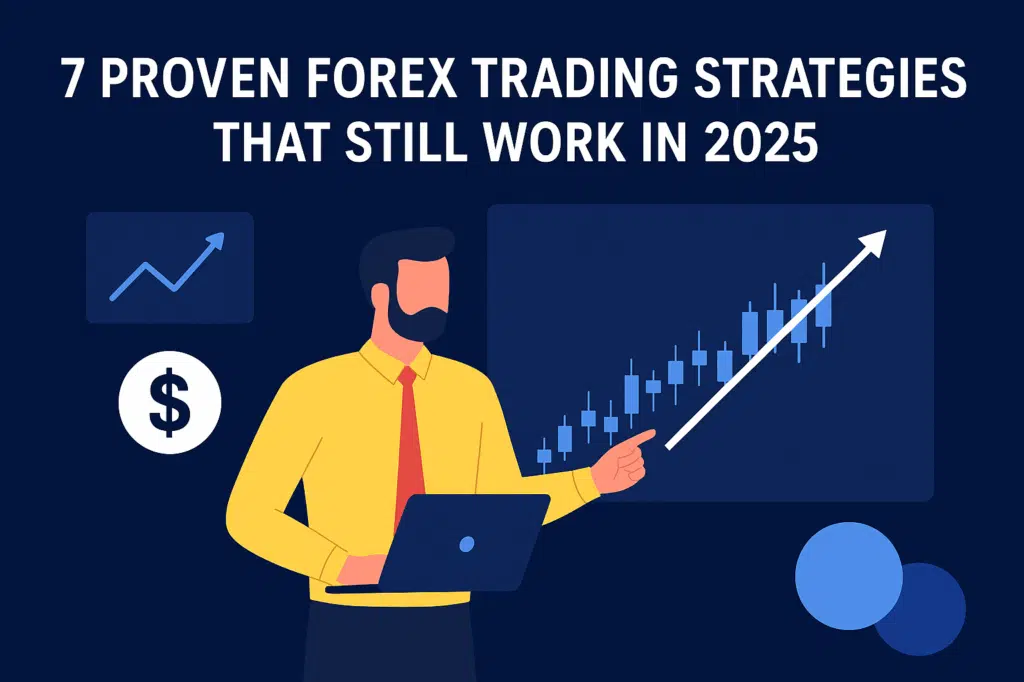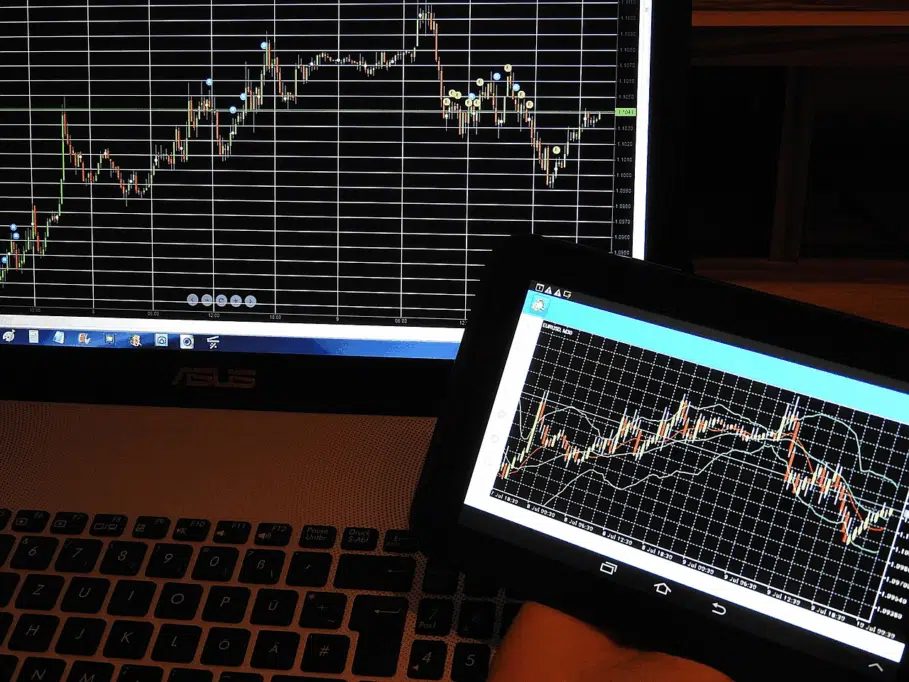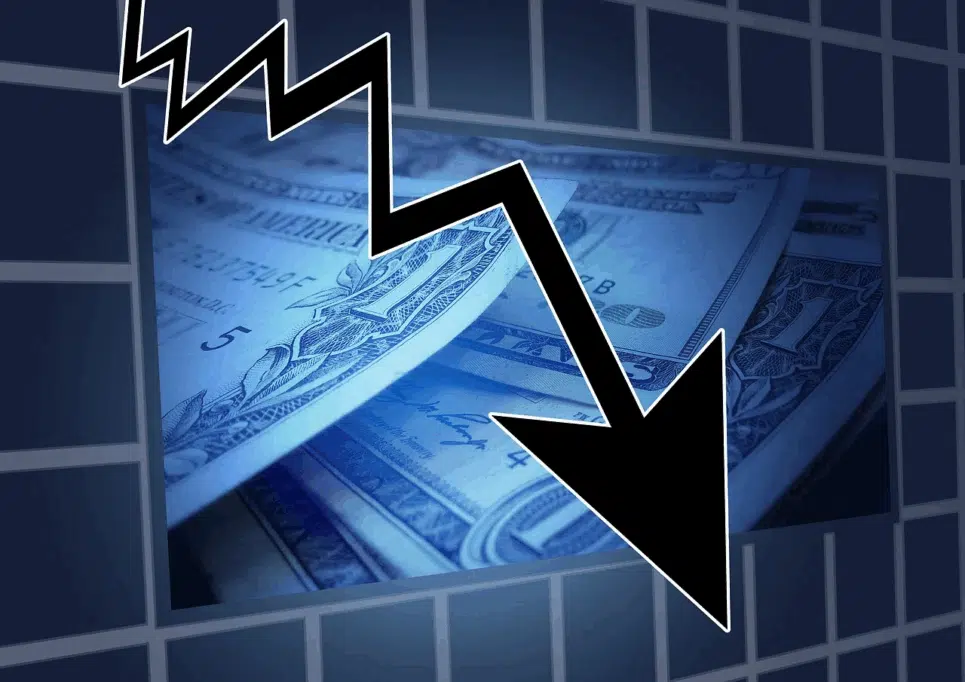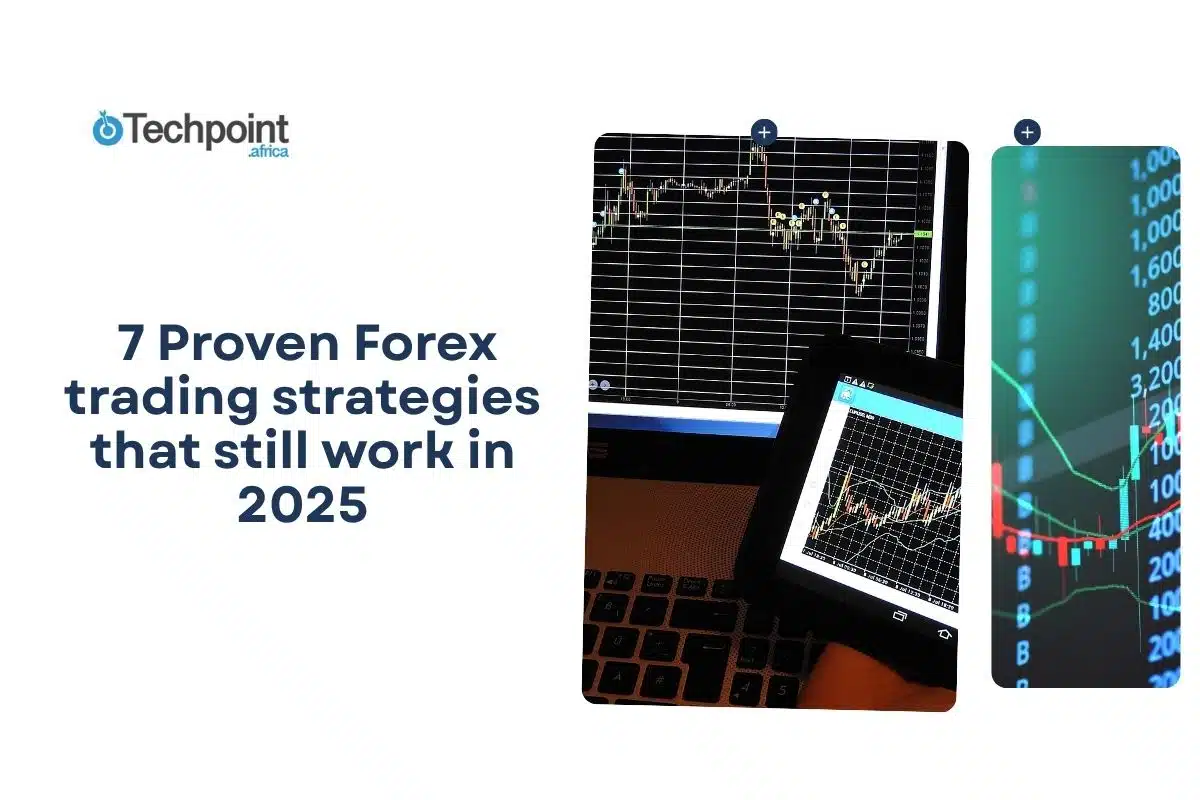
Every day, trillions move through the forex market, and most traders still lose. The difference isn’t luck, it’s strategy. In a space where prices shift in seconds, you need more than instinct. You need tested methods that can turn chaos into opportunity.
In this guide, you will learn:
- Seven forex strategies that still hold strong in 2025
- The tools and indicators that make each strategy work
- How to balance risk and reward like a pro
- Smart habits that turn short-term wins into lasting progress
7 Forex trading strategies you should know as a trader
Forex trading has evolved significantly from its traditional reliance on chart watching. Today’s traders have faster tools, tighter spreads, and more data than ever. However, while the market may feel different, the goal remains unchanged. You spot good setups, manage risk, and stay consistent.
The catch is that technology makes everyone quicker, not necessarily smarter. Algorithms, automation, and social trading have raised the pace but not the patience. That’s why proven strategies still matter. The next seven are the ones worth keeping in your playbook this year.

1. News-Based Trading (NFP and Economic Events)
Major market movements typically begin with news. Reports about jobs, inflation, or interest rates can shift currency prices within seconds. News-based trading involves closely monitoring these announcements and positioning yourself when volatility arises.
The Non-Farm Payroll (NFP) report is the best example. It shows how many jobs were added in the U.S. (excluding farm work) and gives a quick read on the dollar’s strength:
- Strong NFP report → USD often rises.
- Weak NFP report → USD may fall.
But success here isn’t about trading the news as it breaks because that’s gambling. You want to prepare and time accordingly.
Here’s how skilled traders handle it
- Check an economic calendar early in the week to spot high-impact events.
- Avoid jumping in right before a release because spreads widen and can trigger stop-losses.
- Wait for the first sharp move to settle, then trade in the direction the market confirms.
- Always set a stop-loss; news volatility can reverse quickly.
Pro tip: write down two quick scenarios before each major release: “If the report beats expectations, I’ll look for [pair] strength. If it misses, I’ll short.”
That single habit turns impulsive guesses into planned reactions, and it’s what separates patient traders from hopeful ones.
If you’re new to this approach, understanding the meaning of NFP in forex is essential. It helps you interpret how U.S. job data influences currency movements and make informed trading decisions during high-impact events.
2. Trend Trading
If there’s one rule that never gets old in forex, it’s that the trend is your friend. Trend trading simply means going with the overall market direction. You’re buying when prices are steadily climbing and selling when they’re clearly falling.
Markets often move in waves. Once momentum builds in a direction, it tends to persist for a while because traders follow the same signals and news triggers. Riding that momentum gives you a higher chance of success.
How to identify a trend
- Look at longer timeframes (4-hour, daily charts).
- Use moving averages; when the short-term average stays above the long-term one, it signals an uptrend.
- Check the Relative Strength Index (RSI) or MACD to confirm strength.
- Draw simple trendlines connecting higher lows (uptrend) or lower highs (downtrend).
When to enter
- Wait for a pullback, which is a brief dip or rise against the main direction, and enter when the trend resumes.
- Avoid buying when the price is already stretched far above support or resistance.
Pro tip: Don’t chase every move. A strong trend gives multiple entry points. Patience pays more than prediction here.
Trend trading suits beginners because it’s clear and structured, but it still rewards discipline. Once you learn to spot patterns and hold your ground, the trend often does the heavy lifting for you.

3. Retracement Trading
Retracement trading involves capitalizing on temporary pullbacks within a strong trend. The market pauses before continuing its main direction. Skilled traders use these pauses to enter trades at better prices.
Instead of jumping in when prices are already soaring or crashing, you wait for a short-term correction. This allows you to enter at a lower risk point, enjoy better profit potential once the trend resumes, and avoid emotional buying at market tops or selling at market bottoms.
How to identify retracements
- Use Fibonacci retracement levels (38.2%, 50%, 61.8%) to spot where pullbacks may end.
- Watch candlestick patterns like hammers, engulfing candles, or pin bars; they often signal the end of a retracement.
- Confirm with indicators such as RSI returning from overbought or oversold zones.
Step-by-step approach
- Identify the main trend using daily or 4-hour charts.
- Wait for a clear pullback against that trend.
- Mark potential entry points using Fibonacci or trendline support/resistance.
- Enter when the price shows signs of resuming the trend.
- Place a stop-loss slightly beyond the retracement zone to protect capital.
Pro tip: Retracement trading requires patience and confirmation. Don’t mistake a full reversal for a retracement; always wait for clear continuation signals before entering.
This strategy strikes a nice balance between risk and reward, making it a favorite among swing and position traders who prefer precision over constant chart monitoring.
4. Breakout Trading
Breakout trading is all about catching big moves early when the market finally bursts out of a tight range. The longer prices stay trapped between support and resistance, the stronger the breakout tends to be once it happens.
Markets often consolidate before significant moves. When price breaks through a well-tested barrier, it signals fresh momentum and a shift in trader sentiment. That’s your cue to enter early and ride the wave.
How to spot a breakout setup
- Watch horizontal levels where price has bounced multiple times.
- Use chart patterns like triangles, flags, or rectangles. They often precede strong breakouts.
- Keep an eye on volume spikes. A real breakout typically accompanies higher-than-normal trading activity.
- Confirm direction using momentum indicators like MACD or ADX.
How to trade it
- Identify a clear consolidation area (price moving sideways).
- Set alerts slightly above the resistance level or below the support level.
- When the breakout occurs, confirm with a strong candle close that extends beyond that zone.
- Enter the trade, setting a stop-loss just inside the broken range.
- Let profits run, but watch for false breakouts (known as “fakeouts”).
Pro tip: Fakeouts happen often, so confirmation is everything. Wait for the price to retest the breakout level and hold before committing fully.
Breakout trading is particularly effective in volatile markets or during major news events. It’s fast-paced, exciting, and can deliver strong returns when done with discipline.

5. Range Trading
Range trading is one of the simplest, yet most reliable, forex strategies when the market isn’t trending. Instead of chasing big moves, you trade within a box, buying low and selling high as the price bounces between two clear levels.
Markets usually move sideways up to 70% of the time. During those periods, prices respect support (the floor) and resistance (the ceiling). Traders who can identify those boundaries can make steady profits without waiting for major breakouts.
How to identify a range
- Price moves horizontally instead of forming higher highs or lower lows.
- Support and resistance are clearly visible on the chart.
- Indicators like RSI often oscillate between 30 and 70.
- Volume stays consistent, not spiking as it does during big moves.
How to trade it
- Buy near support when the price approaches the lower boundary.
- Sell near resistance when the price nears the upper boundary.
- Use tight stop-losses just outside the range in case of a breakout.
- Take profits early, don’t hold too long waiting for a perfect reversal.
Pro tip: Combine range trading with RSI. When RSI dips near 30 at support, it’s a strong buy signal; when it’s near 70 at resistance, it’s time to sell.
This strategy fits traders who prefer a calm, structured approach over chasing trends. It rewards patience, consistency, and clean technical setups.
6. Swing Trading
Swing trading is ideal for traders who want profits without staring at charts all day. It’s a mid-term strategy that captures swings in price, the natural ups and downs within a broader trend. You might hold a trade for a few days or even a couple of weeks, aiming to catch the middle portion of a move rather than every tick.
Why traders love it
- It balances time and opportunity; no need for 24/7 monitoring.
- It accommodates busy schedules while still offering strong returns.
- Price swings are usually easier to identify, thanks to clear entry and exit points.
How it works
- Identify the overall trend, using tools like moving averages or trendlines.
- Wait for a temporary pullback (a small opposite move).
- Enter when momentum shows signs of returning in the trend’s direction.
- Use support/resistance or Fibonacci retracement levels to plan entries and exits.
Example: Suppose EUR/USD has been trending upward for weeks. It suddenly dips to a key support zone, and RSI shows oversold conditions. That’s your window to enter a long trade as momentum shifts back up, ride the swing, and exit before exhaustion sets in.
Pro tip: Set realistic targets. Don’t chase every pip. Many swing traders aim for 1.5x–3x their risk per trade. And because trades last longer, keep an eye on economic events that might shake your chosen pair.
Swing trading rewards traders who are patient yet strategic, those who prefer quality setups over quantity.
7. Position Trading (Long-Term Strategy)
Position trading is the slow and steady approach to forex. Instead of chasing daily price moves, you focus on the big picture, holding trades for weeks, months, or even years. The goal is to capitalize on major economic trends and fundamental shifts, rather than focusing on short-term volatility.
Why it’s powerful
- It’s based on macroeconomic analysis like interest rates, inflation data, and global news.
- Requires less frequent trading, so emotions don’t cloud decisions.
- Perfect for traders who prefer a hands-off, strategic approach.
How it works
- Study long-term economic indicators (like GDP growth, central bank policies, or employment data).
- Use weekly or monthly charts to spot dominant trends.
- Enter trades when technical and fundamental factors align.
- Set wide stop-loss levels and let trades breathe — short-term dips don’t mean failure.
Example: If the U.S. Federal Reserve signals prolonged rate hikes while the Eurozone faces economic stagnation, a position trader might go long on USD/EUR, expecting the dollar to strengthen over several months.
Pro tip: Patience is your best asset. Position trading works best when you treat forex as a marathon, not a sprint. Check your positions periodically, but don’t overreact to daily noise.
This strategy attracts traders who think like investors, those who study economies, anticipate policy changes, and play the long game.
Extra: Scalping and Short-Term Profits
For traders who prefer rapid results, scalping focuses on executing multiple trades within minutes to capture tiny price changes. The 1 minute scalping strategy is one of the most popular methods, relying on speed, accuracy, and low spreads.
This technique demands focus and discipline. Even a few seconds of delay can affect profit margins. That’s why using a broker with tight spreads and reliable execution is crucial for scalpers.
Pro tip: Scalping works best during high liquidity periods — typically when London and New York sessions overlap.
Tools and Indicators worth knowing
No strategy stands strong without the right tools. These platforms and indicators help traders act with precision instead of guesswork:
- Real-Time Charting Software (e.g., TradingView, MetaTrader): Visualize live price movements, apply technical indicators, and test strategies before risking real money. A clean chart setup often means clearer thinking.
- Volatility Meters and Economic Calendars: Forex thrives on movement. Tools that track volatility help you gauge how risky a pair might be before entering. Economic calendars, on the other hand, alert you to key events like central bank meetings or employment reports that can shake the markets.
- Stop-Loss Automation and Position Sizing Calculators: These keep greed and panic in check. Automation ensures you exit losing trades at pre-set limits, while sizing calculators tell you exactly how much to risk per trade, protecting your capital from emotional decisions.
Smart traders use these tools as a safety net. The aim is clarity and discipline, not overcomplication.
Execution tools that support your trading plan
While strategies and discipline matter most, it depends on how well you can execute them. Even the best plan can fail if spreads are unpredictable, withdrawals are slow, or the platform lags. That’s why choosing a broker that consistently delivers is part of a professional trader’s workflow.
Exness stands out for features that directly support these strategies:
- Stable, tight spreads: Essential for scalping, breakout, or retracement trades. On Raw/Zero accounts, spreads start at 0.0 pips, helping entries and exits align with your plan.
- Reliable, near-instant withdrawals: Knowing your capital is accessible quickly keeps risk management precise.
- Flexible accounts and leverage: Standard, Raw, Zero, and Pro accounts with leverage up to 1:2000 (depending on region) allow strategy-specific setups.
- Regulation and safety: Licenses from the FCA, CySEC, and FSCA, along with segregated client accounts, ensure funds are secure, allowing you to focus on strategy.
- Integrated tools: MT4/MT5 support, Trading Central signals, and economic calendars help confirm trends, breakouts, or retracements before entering trades.
By picking a broker with execution quality and reliable tools, you’re trading under conditions that let your strategy work.
Final takeaways
- Strategy only works when paired with structure.
- The right tools make the market clearer, not easier.
- Good traders don’t chase wins; they manage losses well.
- The right tools sharpen judgment; they don’t replace it.
- Risk control and emotional restraint are what separate seasoned traders from hopeful ones.
Conclusion
Forex trading rewards those who follow a disciplined process. Strategies provide the framework, but mindset, risk management, and execution define results. Every chart, every loss, and every small win is feedback, data to refine your approach. Stay methodical, let evidence guide your trades, and avoid impulsive decisions. Over time, the traders who protect capital, adapt quickly, and execute with precision are the ones who consistently succeed.
The market doesn’t owe anyone profit, but it always rewards preparation. You can learn more or open a demo account on the Exness official site to test your strategy before trading live.
More to read
Best AI trading tools for crypto trading












